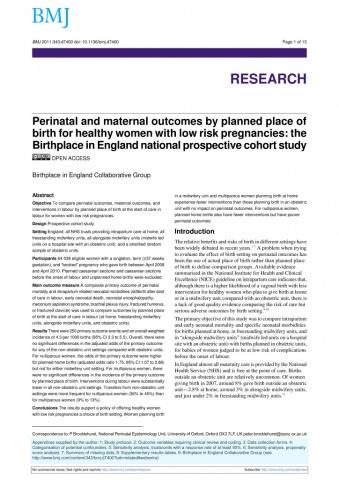Sobre el Birth Place Study- estudio del lugar del parto y nacimiento
Texto por Beverley Beech, presidenta de AIMS (Association for Improvements in the Maternity Services/ Reino Unido), traducido por Andrea Anguera

Este estudio (Birth Place Study o Estudio sobre el lugar del parto) demuestra que para las mujeres con embarazos de bajo riesgo es más seguro dar a luz en centros que no están atendidos por ginecólogos, sino en casas de partos independientes atendidos por comadronas o en el propio hogar. A estas mujeres se les realizan menos cesáreas y episiotomías, se usan menos ventosas y sufren menor pérdida de sangre, entre otros beneficios. Dichos resultados tienen también implicaciones positivas que el estudio en sí no pudo considerar, como por ejemplo mayores tasas de amamantamiento y partos futuros más seguros.
El estudio no mostró diferencia en segundos o subsecuentes partos según el lugar del parto para el bebé, ni tampoco en madres primerizas entre atención en casas de parto y ginecólogos aunque sí mostró un pequeño, pero estadísticamente significativo, riesgo para los bebés de madres primerizas nacidos en casa. Sin embargo la conclusión no es directa.
Para poder obtener la financiación para el estudio los investigadores necesitaban una medición de resultados que pudiera mostrar una diferencia estadística entre los grupos, lo cual no es posible debido al reducido número de muertes perinatales en general. Para poder detectar una diferencia en un suceso que tiene tan baja incidencia se necesitaría una muestra mucho mayor que 65.000 mujeres. Debido a esta dificultad, los investigadores pusieron en el mismo saco resultados muy diversos: partos no vivos después del inicio de la atención al trabajo de parto, muerte neonatal temprana, encefalopatía neonatal, síndrome de aspiración de meconio, lesiones del plexo braquial, fracturas de húmero y de clavículas. Por este motivo es evidente que lo que sí se puede asegurar es que para las mujeres es más seguro tener sus bebés en casa o en casas de parto independientes, pero en cuanto a que haya mayor o menor riesgo de muerte perinatal para el bebé, no hay evidencia.
En toda Europa se debería hacer de conocimiento este estudio a toda la comunidad profesional médica.
El título completo del estudio es:
"Perinatal and maternal outcomes by planned place of birth for healthy women with low risk pregnancies: the Birthplace in England national prospective cohort study"
Texto original:
Comment on the BirthPlace Study
The debate about the safety of hospitals and the risks of home birth has been much debated since the publication of a long-awaited large prospective cohort study of 64 538 eligible women with a singleton, term (≥37 weeks gestation), and “booked” pregnancy who gave birth between April 2008 and April 2010. Planned caesarean sections and caesarean sections before the onset of labour and unplanned home births were excluded. (Brocklehurst, P 2011).
This research (known as the BirthPlace Study) shows that low-risk women are safer when they give birth outside an obstetric unit, in alongside or free-standing midwifery units, or at home. Women have fewer caesarean, ventouse deliveries, episiotomies, less blood loss, and other benefits. These outcomes will have benefits that this study was unable consider, such as better breastfeeding rates and safer future births.
The study showed no difference for second or subsequent babies by place of birth, nor for first time mothers between midwifery units and consultant units. However, a small statistically significant increased risk was shown for babies of first time mothers born at home. However, in order to gain finance for the study the researchers will have required an outcome measure that had a chance of showing a statistically significant difference between the groups and baby deaths would have been too few to do this. So they combined: stillbirth after the start of care in labour, early neonatal death, neonatal encephalopathy, meconium aspiration syndrome, brachial plexus injury, fractured humerus, and fractured clavicle. So, what can be said is that women are safer having their babies at home or in midwifery units, but there is no evidence about whether there is an increased risk of stillbirth or neonatal death for the baby because the incidence of this is so small we would need a much bigger study than the 65,000 women in this study in order to be able to detect a difference. The attention of the medical profession in every country in Europe should be drawn to this study.

